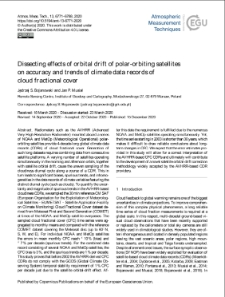Biblioteka Cyfrowa Instytutu Geodezji i Kartografii contains 1 101 digital objects
Object
Title: Dissecting effects of orbital drift of polar-orbiting satellites on accuracy and trends of climate data records of cloud fractional cover
Abstract:
Publisher:
Date issued:
Format:
Resource Identifier:
DOI:
Language:
Relation:
Atmospheric Measurement Techniques
Is part of:
Access rights:
Dla wszystkich w zakresie dozwolonego użytku
License:
Object collections:
Last modified:
Dec 21, 2020
In our library since:
Dec 21, 2020
Number of object content hits:
170
Number of object content views in PDF format
197
All available object's versions:
http://bc.igik.edu.pl/publication/1128
Show description in RDF format:
Show description in OAI-PMH format:
Objects Similar
Jędrzej Bojanowski Jan Musiał
Bojanowski, Jędrzej Musiał, Jan
Musiał, Jan Bojanowski, Jędrzej
Bojanowski, Jędrzej Stöckli, Reto
Kulesza, Kinga Bojanowski, Jędrzej S.
Musiał, Jan
Bojanowski, Jędrzej Stöckli, Reto Duguay-Tetzlaff, Anke Finkensieper, Stephan Hollmann, Rainer
Musiał, Jan Dąbrowska-Zielińska, Katarzyna Kiryła, Wojciech Oleszczuk, Ryszard Gnatowski, Tomasz Jaszczyński, Jacek

